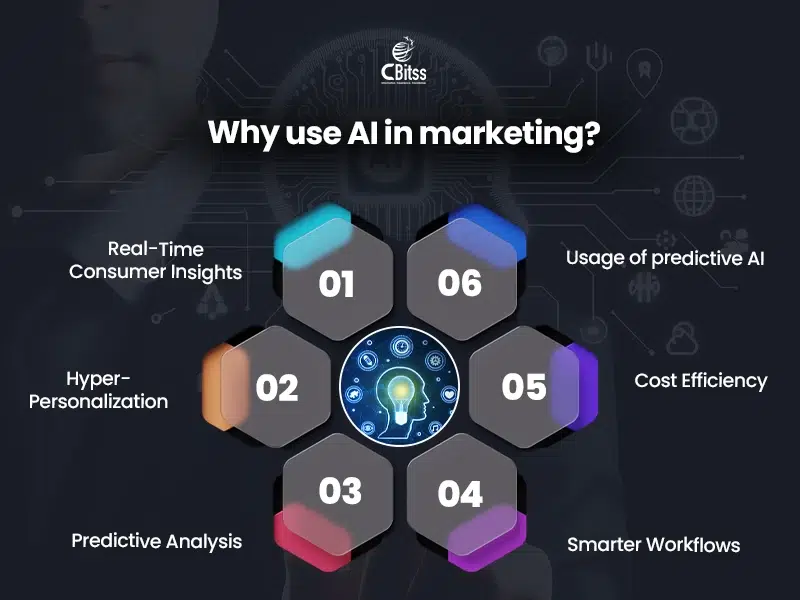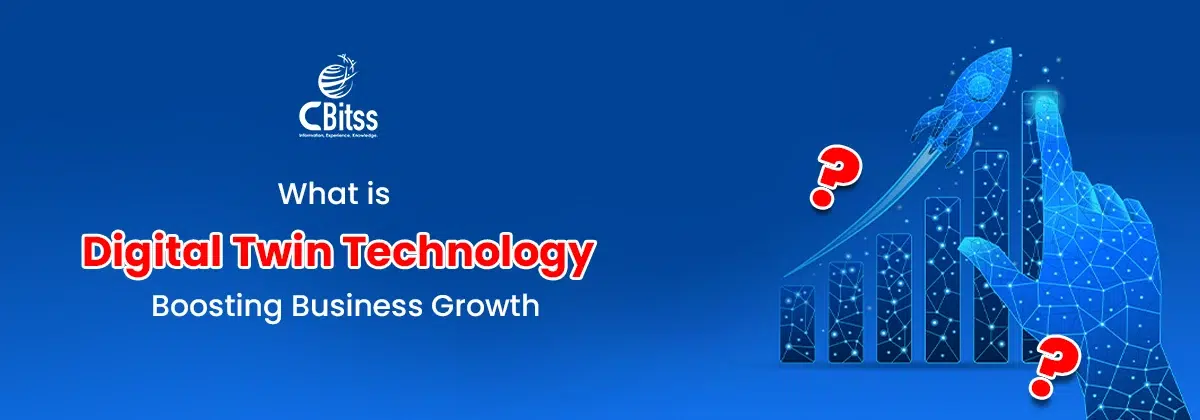Table of Contents
ToggleDue to the rapid increase in the popularity of artificial intelligence, today hardly any company remains without using AI in some way, whether it is the development of content, automation, or analytics. The use of traditional marketing strategies is not sufficient anymore.
Businesses need to understand the process of how to design an AI marketing strategy to survive in the competitive world. In the current society, knowledge of how to leverage AI in marketing is essential to any firm for expansion.
The AI is transforming the way brands engage their audience in personalized email campaigns, prediction, and the use of intelligent chatbots, etc. Just like AI-driven methods, high conversion rates on Facebook ads are redefining how companies approach digital advertising.
However, effective use of AI is not picking and choosing the tools at random; it is about coordinating the correct technology to meet your business objectives, audience, and data. Being aware of how to utilize this may help to distinguish between an average and an effective campaign. Similarly, understanding AdWords call-only campaigns can make your outreach more result-oriented.
This guide will teach you to develop a results-based approach to this strategy, step-by-step. The knowledge of marketing and AI will allow businesses to reduce the time spent on campaigns, target the correct audience, and have the best ROI.
What is an AI Marketing Strategy?
Due to the rapid increase in the popularity of artificial intelligence, today hardly any company remains without using AI in some way, whether it is the development of content, automation, or analytics. The use of traditional marketing strategies is not sufficient anymore.
Businesses need to understand the process of how to design an AI marketing strategy to survive in the competitive world. In the current society, knowledge of how to leverage AI in marketing is essential to any firm for expansion.
The AI is transforming the way brands engage their audience in personalized email campaigns, prediction, and the use of intelligent chatbots, etc. Just like AI-driven methods, high conversion rates on Facebook ads are redefining how companies approach digital advertising.
However, effective use of AI is not picking and choosing the tools at random; it is about coordinating the correct technology to meet your business objectives, audience, and data. Being aware of how to utilize this may help to distinguish between an average and an effective campaign. Similarly, understanding AdWords call-only campaigns can make your outreach more result-oriented.
This guide will teach you to develop a results-based approach to this strategy, step-by-step. The knowledge of marketing and AI will allow businesses to reduce the time spent on campaigns, target the correct audience, and have the best ROI.

What is an AI Marketing Strategy?
This strategy can be described as a tangible process that employs the use of AI tools and techniques to automate and optimize the marketing process. These AI-enabled tactics are swift, data-centric, and changing 24/7. Because it is data-driven, algorithm, and machine-learning-based, they are quicker in decision-making and provide real-time solutions.
The role of AI in the context of AI-driven marketing strategies comes in the form of enabling businesses to put insights from different sources into action as fast as possible. Platforms like WordPress for business websites also integrate AI plugins for speed and personalization.
How is this different from traditional marketing?
| Category | AI Marketing Strategy | Traditional Marketing |
| Approach | Automated, optimized, and data-driven in approach | Broad and manual in approach |
| Audience Targeting | Results driven by real-time behavior, preferences, and predictive analysis. | Results driven by past assumptions or past demographics |
| Messaging | Real-time personalized messages for the audience | Predefined messages for groups or teams. |
| Campaign Structure | Campaigning continuously through machine learning | Campaign through a set that is fixed |
| Performance Tracking | Instant feedback and monitoring performance | Delayed feedbacks |
| Speed | Fast deployment/implementation and adaptation | Slow implementation and response |
| Ad Placement | Automatically placed based on audience behavior and data | Manually planned and scheduled |
| Examples | Predictive emails, smart chatbots, and AI-generated content | TV ads, print media, radio, and flyers |
| User Insights | Drawn from real-time data, behavioral patterns, and predictive models | Gathered through surveys, historical trends, and manual analysis |
Additionally, Google’s Page Speed Insights plays a vital role in analyzing performance for AI-powered campaigns.
Why use AI in marketing?
AI isn’t just a new tool in the marketing world, but has become an inevitable tool that has been transforming businesses to connect with their audience. Understanding how this works will allow businesses to stay ahead of competitors.
Below is why AI is becoming essential in modern marketing strategies.
Real-Time Consumer Insights
Artificial Intelligence can help marketers know what the customers want, their behavior, and their interaction with the content in real time. This enables companies to respond fast, such as sending the correct offer at the correct time, something that conventional marketing cannot do. AI for digital marketing requires AI since it will render them actionable and in real-time.
Hyper-Personalization
It enables brands to deliver personalized messages that are specific to the behavior, use of devices, location, and previous purchases. As opposed to treating all people in the same manner, companies can provide content that each is most likely to utilize. With the help of AI-driven marketing strategies such personalization becomes automated and ongoing. Even UI/UX design strategies contribute heavily to ensuring personalization is impactful.
Predictive Analysis
This is one of the strongest aspects of AI, which is the ability to make a presumption about the next action taken by the customer. It can predict the chance of who is likely to remain with the brand, or change somebody, or who is ready to purchase. Such foresight will enable the companies to act on time before it is too late, such as rewarding a customer who is walking out with a discount or sending a reminder to a customer who has yet to make a purchase. Marketers can now be one step ahead of reacting.
Learn how AI transforms education marketing with data-driven strategies
Usage of predictive AI
Learning how to leverage AI in marketing can assist marketers in lowering turnover and raising conversions. Marketers can now be one step ahead of reacting, just like developers adapt to Android runtime optimizations and Android instant apps for smoother customer engagement.
Cost Efficiency
Traditional marketing is normally slow and a manual process that requires trial and error, and this comes at a cost of time and money. AI changes that. It automates, optimizes campaigns, and enhances targeting. So, it reduces time wastage as budgets are utilized more efficiently.
Since the decisions are made using the actual information and not mere instinct, companies are able to evade excess spending and obtain superior outcomes without going overboard.
Smarter Workflows
Instead of doing the same tasks over and over, like sending emails, posting content, or replying to common customer questions, AI handles it automatically and intelligently. Using this in marketing enables smarter workflows, which is why AI for digital marketing adoption is rapidly increasing.
Learn proven AI frameworks to maximize results in education marketing
How to Design an AI Marketing Strategy and Its Core Components
What then is the actual process of creating an AI marketing plan that will be effective?
It is not enough to use AI tools and hope that they will make a difference in your process. You must have a solid base that would get the two aligned, your business needs, and the power of AI.
Here’s how to break it down:
Define Your Business Goals
Get very clear on what you are attempting to accomplish first. AI is just that, a tool; it can only be effective when applied to an end.
Ask yourself:
- Would you like to drive up sales?
- Are you attempting to receive more leads?
- Are you in need of retaining customers or limiting churn?
- Or perhaps you need to enhance your customer service or assistance?
Your goals must be specific and measurable, regardless of their nature. It will assist you in making better decisions on the use of AI tools at a later point in time and monitoring their effectiveness.
Understand Your Data
AI is a data-driven technology, and whereas you are supposed to know the type of data you currently have, where it is originating, and how it is clean or useful. Start with:
Your customer relational management (customer records, purchase history, preferences)
- Visitor information about your site (views, clicks, time)
- Insights into social media
- Email activity (open, clicks, unsubscribed)
After knowing what is available, consider the structure of the same.
- Is it current?
- Does it embrace segmentation?
This step refers to making your data organized in a way that the AI tools can actually make sense and provide you with some meaningful results.
Choose the Right AI Tools for Your Business
Now that you have your goals and your data, it’s time to pick the right tools that fit your needs. It is not necessary to apply all at the same time. Therefore, you can start with something that would have the biggest effect.
Some examples are as follows:
- In customer support: Use chatbots that can answer FAQs and lead users in real time, e.g., Drift, Intercom, or Tidio.
- To personalize email: AI-based email tools, such as Mailchimp or ActiveCampaign, can deliver a personalized approach according to user data.
- Content and copywriting: Use copywriting and content acceleration tools such as ChatGPT, Jasper, or Writesonic to accelerate blog/ad/social media content.
- Ads and targeting: Test Meta Advantage+ or Smart Campaigns on Google that can automatically place ads depending on user information.
However, there is one thing one should keep in mind. You need not select a tool due to its popularity, but because it can address a particular issue in your business.
As a result, it is not only time-saving. AI is trained to know what works and to be better at what it does. And you can eliminate basic automation; it is intelligent execution. It assists teams in thinking bigger.
How to Design an AI Marketing Strategy and Mistakes to Avoid?
Even with the best tools and ideas, AI won’t deliver results if certain key things are overlooked.
Here are a few mistakes you should avoid when building your strategy:
Relying on AI Alone: AI is smart, but not human. Don’t replace creativity, storytelling, or your brand voice with it. People don’t just want information; they want emotion, storytelling, and creativity. That can only come from you or your team. AI should work as a support system, not a replacement. Marketing and AI should work hand in hand.
Avoid Ignoring Data Privacy: As we respect customers’ data, we should comply with regulations like GDPR. Get users’ consent, securely store data, and use it carefully.
Selecting Tools Before Goals Are Clear: Don’t begin to select AI tools until you know what you’re trying to accomplish. It can be exciting to explore different tools, but it is not always result-driven. If you don’t choose the right tool, you will probably waste your time.

Conclusion
Lastly, the question of how to design an AI marketing strategy is a guide, and it was never designed to replace human ingenuity, judgment, or connection. It is a strong support system, but it only works with a clear human vision.
Every marketing activity is aimed at reaching your audience and building relationships to achieve sales, leads, or loyalty. For AI to succeed, clarity must come first. The two skills of marketing and AI will assist in ensuring that your campaign is goal-oriented, designed, and trackable.
Therefore, do not pressure yourself to use all AI instruments in your marketing.
Start putting the AI to work on automation and data, and use your intent, voice, and values as the driver.
Remember, the challenge in the design of an AI marketing strategy is not just tools: it is a strategy, purpose, and outcome. Begin to build yours today!
Want to Design a Winning AI Marketing Strategy?
If you’re ready to turn ideas into impact, CBitss in Chandigarh offers hands-on AI-powered digital marketing training that helps you master automation, data insights, and real-world strategies. Don’t just follow trends—become the trendsetter with expert guidance and career-focused learning.

J. Julia Kamei is a professional content writer with 4+ years’ experience creating impactful content for clients in the USA, India, Canada, the UK, and Europe. An M.A. History graduate, she specializes in immigration, business, IT, digital marketing, AI, and Data Science. She also mentors students for international education and research.







